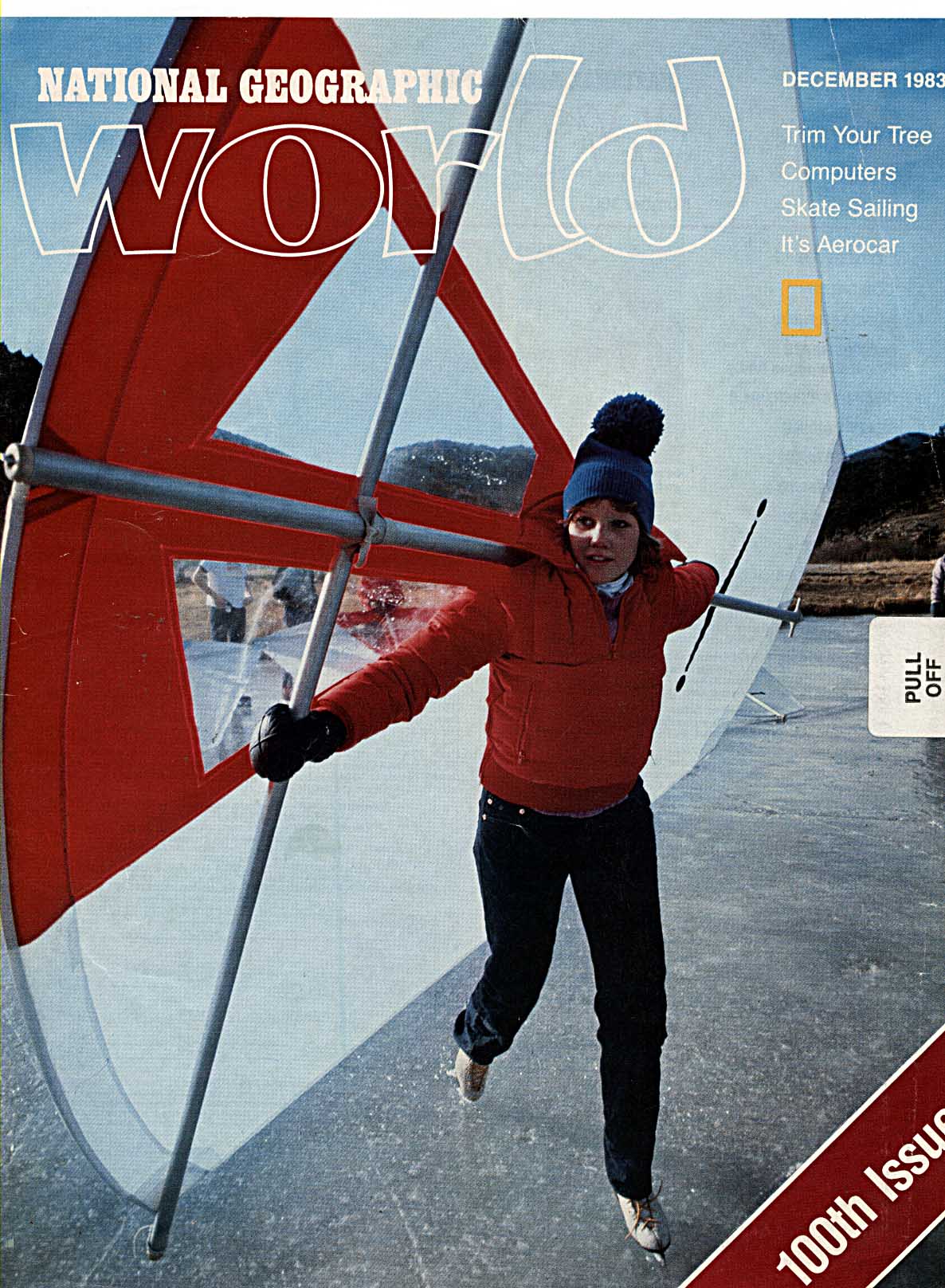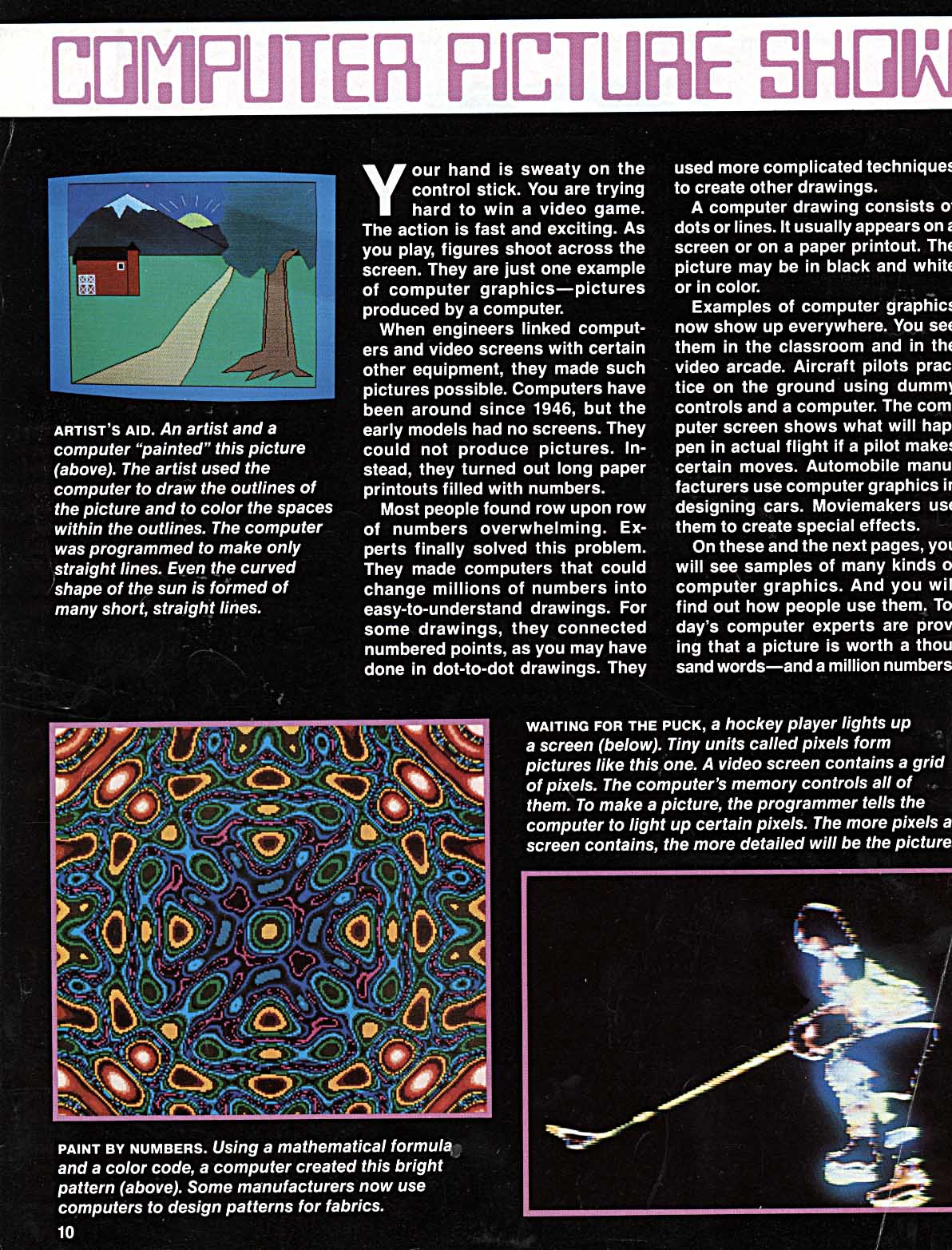Computer Picture Show
By studying moving images from different angles engineers can predict what machines in motion will do
By Unknown in National Geographic World on Thursday, December 1, 1983
Artist's Aid: The Intersection of Art and Technology
This article discusses the integration of art and technology, specifically how artists are utilizing computers to create intricate designs. The computer is programmed to draw straight lines, forming complex shapes and figures. The article also highlights the evolution of computers, from early models that produced numerical printouts to modern ones capable of transforming millions of numbers into comprehensible drawings.
Computer graphics are now ubiquitous, appearing in classrooms, video arcades, and even in the design process of cars and movies. The article also discusses the concept of pixels, the tiny units that form pictures on a screen. The more pixels a screen contains, the more detailed the picture will be.
The article further explores the dynamic nature of computer graphics, which can change and move, providing different perspectives of an object. This feature is particularly useful in fields like engineering and sports, where motion analysis is crucial.
The article concludes by discussing the work of Gideon Ariel, a computer and sports expert who has developed a system to analyze athletes' motions using computer graphics. This technology has proven beneficial in improving athletes' performance.
Tip: use the left and right arrow keys
ARTIST'S AID. An artist and a computer "painted" this picture
(above). The artist used the computer to draw the outlines of the picture and to color the spaces within the outlines. The computer was programmed to make only straight lines. Even the curved shape of the sun is formed of many short, straight lines.
Y our hand is sweaty on the control stick. You are trying hard to win a video game. The action is fast and exciting. As you play, figures shoot across the screen. They are just one example of computer graphics-pictures produced by a computer.
When engineers linked computers and video screens with certain other equipment, they made such pictures possible. Computers have been around since 1946, but the early models had no screens. They could not produce pictures. Instead, they turned out long paper printouts filled with numbers.
Most people found row upon row of numbers overwhelming. Experts finally solved this problem. They made computers that could change millions of numbers into easy-to-understand drawings. For some drawings, they connected numbered points, as you may have done in dot-to-dot drawings. They
used more complicated technique to create other drawings.
A computer drawing consists dots or lines. It usually appears on screen or on a paper printout. Th picture may be in black and whit or in color.
Examples of computer graphic now show up everywhere. You se them in the classroom and in th video arcade. Aircraft pilots pra tice on the ground using dumm controls and a computer. The co puter screen shows what will ha pen In actual flight if a pilot make certain moves. Automobile man facturers use computer graphics i designing cars. Moviemakers us them to create special effects.
On these and the next pages, yo will see samples of many kinds computer graphics. And you wi find out how people use them. T day's computer experts are pro ing that a picture is worth a tho sand words-and a million number
WAITING FOR THE PUCK, a hockey player lights up
a screen (below). Tiny units called pixels form pictures like this one. A video screen contains a grid of pixels. The computer's memory controls all of them. To make a picture, the programmer tells the computer to light up certain pixels. The more pixels a screen contains, the more detailed will be the picture
PAINT BY NUMBERS. Using a mathematical formula and a color code, a computer created this bright pattern (above). Some manufacturers now use computers to design patterns for fabrics.
10
DIY SPORTS-IN SPACE
C omputer pictures can change before your eyes. The images can zoom toward you or away from you. They can turn to the right or to the left. They can spin end over end. You can see the top, bot
tom, and side views of an object. Computer graphics
can show in seconds how a continent forms over mil
lions of years. They can slow down fast action so that
you can look at it closely.
By studying moving images from different angles,
engineers can predict what machines in motion will + C 0
do. This helps them design automobiles and aircraft, f and plan space-shuttle flights and moon landings.
Computer graphics can help athletes, too. Gideon UP AND OVER. Stick figures represent Dutch high Ariel is an expert both in computers and in track-and- jumper Ruud Weilart in motion. Ariel studied the series field sports. He invented a system that analyzes ath
letes' motions. Ariel first films an athlete in action. Then he runs the film very, very slowly. After every few frames, he stops the action. Using a special pen, he shows the computer the positions of the athlete's elbows, knees, and other joints. Then he programs other information into the computer. He tells it how fast the athlete is moving and where the athlete's centdr of gravity is. The computer converts this Information into stick figures that show the movements of the real athlete. Ariel studies the figures and adjusts them. Then he suggests ways the athlete can Improve.
c
4~:p=
COMPUTER EXPERT Gideon Ariel (above) turns a film into a computer picture. He uses a pen that produces sound. Each time the pen touches a spot on the movie screen, tiny microphones record the pen's position. The computer turns the sound recordings into a stick figure on the computer screen.
12
./. I"+I 1-1 �I 0-..1,10. f, -- ...NAM,
I
l I IXI 1.1 U L I*�I I-R I+I 1-11-1171 U
of figures. Then he told the computer to thrust the ath- jump. The jump improved on the screen. Weilart
lete's right arm up more strongly at the beginning of the copied the change, and his jumps improved, too.
i
SAFETY TEST. A satellite launched from a space shuttle tumbles across a computer screen. The series of drawings indicates the satellite's position every 15 seconds. This kind of picture helps engineers spot possible problems before a flight. If this were a real flight, the satellite and the shuttle would come dangerously close together. After looking at this picture, the engineers could determine how to launch the satellite safely.
1
L
13




